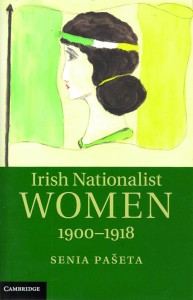Irish nationalist women, 1900–1918
Published in Issue 3 (May/June 2014), Reviews, Volume 22SENIA PASˇETA
Cambridge University Press
£60
ISBN 9781107047747

Much work has been done on nationalist women in the early twentieth century. Beginning in 1922 with Helena Concannon’s Daughters of Banba, this is a much-tilled field that has attracted scholars from Ireland, Britain, France, Australia, Finland, the United States and New Zealand. Maire O’Neill, with biographies of Grace Gifford Plunkett, the tragic bride of 1916, and the versatile Jennie Wyse Power, whose career ranged from suffrage to the Seanad, is given due credit, but so is Ann Matthews, whose ‘myth-busting’, in Pasˇeta’s words, is ‘inspiring’. Unlike Matthews, however, Pasˇeta empathises with her subjects. There was a need for balance and this elegantly written book provides it.
Pasˇeta’s seminal book begins in 1900 with the establishment of various nationalist organisations in the wake of the Boer War and concludes with the achievement of voting rights for many men and women eighteen years later. Pasˇeta places much value on primary sources, a much-needed corrective given that there is so much we do not know, and many gems were unearthed by her industry in archives and libraries. I was pleasantly surprised to learn new things about Dr Kathleen Lynn, chief medical officer of the Irish Citizen Army during the 1916 Rebellion, and Madeleine ffrench-Mullen, her great friend or sexual partner, depending on your point of view or the level of research one has conducted. Lynn was in prison when the 1916 executions took place and Pasˇeta makes excellent use of her diaries, which she maintained from 1916 until her death in 1955. For instance, Lynn’s financial woes after 1916, when she was prevented from seeing her patients, are indicative of the sacrifices to patriotism made by working-class and middle-class women. With the benefit of hindsight, much writing on Irish women’s history is presentist, pathologically projecting current issues on to participants in past events. In the 1973 words of Joe Lee, in relation to secret societies such as Ribbonmen in the nineteenth century, some historians ‘conveniently press yet another complex chapter of Irish history into the paralysing strait-jacket of nationalist orthodoxy and assert, once more, the triumphant tyranny of the living Irish over their dead generations’. Pasˇeta’s book avoids this because it embraces the empirical approach, and much material, particularly in the National Library of Ireland, has been trawled for evidence.
Given the focus on women, it is revealing how male reputations change after an examination of the contemporary documents. Hence Arthur Griffith, who was very open to females writing in his newspaper, the United Irishman, is rightly praised, whereas John Redmond, the subject of a new biography by Dermot Meleady [reviewed in this issue, pp 56–7], is subjected to the slings and arrows of outraged feminists. Apparently he deserved them. Pasˇeta’s great knowledge of the Irish Parliamentary Party is put to excellent use as she conveys the context of the time. Her chapter on old nationalisms explicitly and politely critiques the way Irish nationalist organisations frequently, and unwisely, excluded women. This deprived them of key workers, who proved their worth particularly when it came to promotion and fund-raising. One of the revelations of this book is the sheer entrepreneurship of many nationalist women, with plays making political points and money. In fact, this book operates in some respects as a business history of the revolution, with the finances of various organisations and the financial demands they made upon members being carefully analysed. This pragmatic approach, especially to cultural politics (for example the Abbey Theatre’s productions), adds to our knowledge of the more recondite aspects of nationalism. Helena Molony, who cries out for a biography, features heavily here as an editor, organiser, actress and ultimately alcoholic. She did not die until 1967.
This book makes several significant contributions to Irish history; it will compel historians to rethink the way they examine the background to the achievement of partial political and economic independence in 1922. Cambridge University Press has meticulously produced this book, with footnotes where they belong—at the bottom of the page. The beautiful front picture from the extensive Kilmainham Gaol archives is a painting of a woman against a tricolour. This painting was contained in the autograph book of May Doyle, an under-utilised source for the material culture of the revolutionary era. Few sources have evaded Pasˇeta and much scholarship will be derived from simply re-examining the sources she imaginatively explores.
Pasˇeta’s extensive bibliography of primary and secondary sources will be a great help to all scholars in the field. The only gaps I noticed were Catherine Morris’s influential book on Alice Milligan, Margaret Mac Curtain’s evocative chapter on women in the revolution, published over a quarter of a century ago, and Joyce Padbury’s five articles on Mary Hayden, the suffragist who became the first Professor of Modern Irish History at University College Dublin in 1911. Nationalist women is the most significant book published on Irish women’s history since Mary Peckham Magray’s The transforming power of nuns was published by Oxford University Press in 1998. Irish women’s history will never be the same again.


















